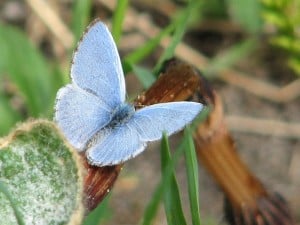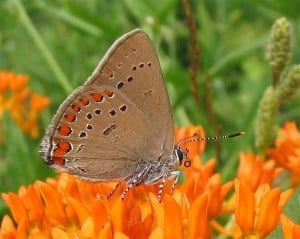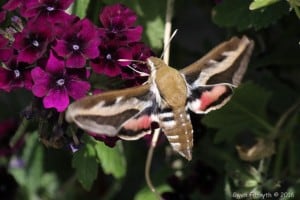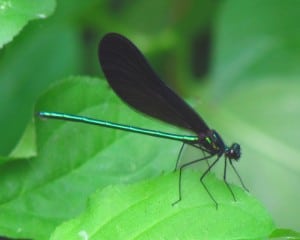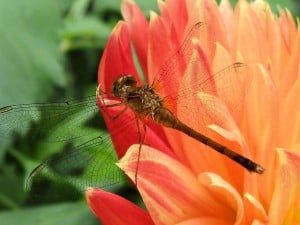The Kawarthas is home to at least 100 species of butterflies, 135 kinds of dragonflies and damselflies and a thousand or more different moths. Learning to identify the more common species is a great way to connect to the natural world around us and get kids interested in nature.
Butterflies
Who has not been enchanted by butterflies – the delicate, colorful wind dancers that are the hallmark of a warm spring or summer day? Belonging to an order of insects known as Lepidoptera, butterflies are easy to observe and turn up everywhere from woodland trails to backyard gardens. In fact, butterfly-watching also adds a whole new level of enjoyment to gardening. Compared to birding, which can involve getting up at the crack of dawn to take advantage of peak avian activity, identifying and photographing butterflies is a more civilized affair. Butterflies are rarely on the wing before 8 am and are most active on warm, sunny days.
Getting good looks at butterflies is easiest with a pair of binoculars, especially those that focus to within six feet or less. A camera with a zoom lens also comes in handy. By taking a picture of the butterfly, you can identify it later. Lots of excellent guide books and apps are available such as the “ROM Field Guide to the Butterflies of Ontario” and the “Audubon Butterflies” app. Some butterfly-watchers also use a net for catching hard-to-identify species such as skippers, which tend to be very similar. The butterfly can be transferred to a plastic viewing jar and then released.
Here are a few additional suggestions to keep in mind.
1. To find a given species, research the time of year it flies and its preferred habitat. Spring azures, for example, are most often seen in May; Canadian tiger swallowtails are active in June, while many of the fritillaries are observed in mid-summer.
2. Roadsides and wetland edges can be particularly productive, as long as there are sufficient flowers in bloom.
3. Learn to identify the plants that attract butterflies, either for nectar or as “larval plants” on which to lay eggs. Among the most important are the milkweeds.
4. Watch for butterflies basking in the sun on gravel roads (e.g., anglewings) and tree trunks (e.g., satyrs). Some species are attracted to animal dung and muddy puddles, which serve as a source of minerals, amino acids and nitrogen.
5. Be careful not to cast a shadow on the butterfly, since this will usually cause it to fly away.
6. Pay special attention to the butterfly’s size, wing shape, color and patterning. The pattern on the underside of the wing, usually visible as the butterfly feeds, is especially important for identification purposes.
Moths
If you would simply prefer that insects to come to you, then moth-watching may be your thing. Mothing, as it is sometimes called, can be as simple as leaving on the porch light and checking periodically to see what’s clinging to the screen door. Unlike butterflies, most moths are nocturnal. However, there are exceptions. To distinguish moths from butterflies, remember that butterflies have club-like knobs on the ends of the antennae and usually perch with their wings held upwards. Moths, on the other hand, perch with their wings outspread and have antennae that closely resemble bird feathers.
While a simple incandescent light will attract some moths, the most effective bulbs are those that project light in the UV spectrum such as a black light CFL. Grow bulbs, designed for plants or aquariums, also work well. An even more effective option is to use a mercury or sodium vapour bulb, which broadcast an extremely bright light and draw in moths from further away. Set the light up in front of a wall or, even better, a white cotton sheet where the moths can land and be studied at close range.
Not all moths, however, are interested in lights. Some are nectar-feeders and will come to bait such as over-ripe bananas. A particularly effective way to entice moths is with a syrupy “goop.” One mixture calls for one over-ripe banana, a dollop of molasses, a scoop of brown sugar and a glug or two of beer. Mix the ingredients in a blender and spread the concoction on a tree trunk or a hanging rope. Check regularly after dark to see what has been attracted. With any luck, species such as Catocala (underwing) moths will show up. During the day, the bait may also attract butterflies.
A lot of the fun in mothing comes from taking pictures of the insects. Be aware, however, that using a flash may create washed-out images. A way to get around this is to carefully catch the moth in a small container, put it in the fridge overnight and take a picture the following morning using natural light. Place the moth on a pleasing background such as a leaf or a piece of bark. Make sure your camera settings are ready, because you will only have 30 seconds or so before the insect warms up enough to fly away. Placing a ruler beside the moth for one of the shots serves as a simple size reference.
Moth identification can be challenging, so keep in mind the following tips:
1. Start by focusing your efforts on the larger moths and those that stand out from the rest because of their large size and distinctive colours and markings (e.g., giant silkworm moths, sphinx moths).
2. Take note of how it holds its wings when at rest. Are they spread out to the side or tent-like over the back? The former is probably a moth in the family Geometridae while the latter likely belongs to the family Noctuidae.
3. Once you have a rough idea of what family the moth might belong to, look more closely at the patterns on its wings and compare these to the photographs in a guide such as “Peterson Field Guide to Moths” by Seabrooke Leckie.
4. Keep in mind the time of year. Like butterflies, the moths you see change with the seasons. Knowing a given moth’s flight period will help to narrow down the species.
5. Look at the range maps and make sure the species occurs in your area.
6. Check the type of host plant (larval food plant) the moth requires. If, for example, a given moth lays its eggs on plants that don’t grow in the Kawarthas, you can probably discount it.
Almost everything that applies to butterfly-watching is also pertinent to the observation of dragonflies and their close cousins, damselflies. Collectively, these two groups of insects are known as the Odonata or simply “odonates.” Like butterflies and moths, there is a great deal of species diversity, and they, too, make wonderful subjects for photography.
On warm, sunny days, dragonflies and damselflies can be found around any wetland, lake or river. Many species are also attracted to meadows, roadsides and backyard gardens. In addition to using binoculars and a camera to help with identification, it can be fun to catch the insect in a butterfly net. It can then be transferred to a transparent jar or plastic bag. Despite what many people think, dragonflies cannot sting you and their “bite” – on the rare occasions when this happens – is usually more startling than anything else. Here are a few simple suggestions to get started as an odonate-watcher.
1. Learn the different dragonfly (e.g., darners, skimmers) and damselfly (e.g., bluets, spreadwings) families. Knowing the family will greatly narrow down the choice of possible species.
2. Pick up a copy of “The Dragonflies and Damselflies of Algonquin Provincial Park and Surrounding Area”. Written by local naturalist Colin Jones and illustrated by former Peterborough resident Peter Burke, it covers all of the species you are likely to find in the Kawarthas.
3. For dragonflies, take special note of overall size, eye position (e.g., do the two large eyes touch each other?) as well as any patterning on the thorax, abdomen or wings.
4. Remember that the male and female in many species can be quite different.
5. As with common moths and butterflies, you may want to start collecting odonates to have a small reference collection. Doing so will not have any impact on the population. Guidelines for proper collecting (e.g., using glassine envelopes) can be found online.
You will find more ways to develop a stronger connection to the natural world in my new “Big Book of Nature Activities: A Year-Round Guide to Outdoor Learning” which I co-wrote with Jacob Rodenburg, executive director of Camp Kawartha. The book will be available in June.
